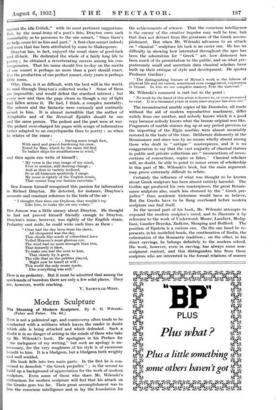Modern Sculpture
The Meaning of Modern Sculpture. By R. H. Wilenski. (Faber and Faber. 10s. 6d.) Tins is not a polemical age, and controversy often tends to be conducted with a mildness which leaves the reader in doubt which side is being attacked and which defended. Such a doubt is in no danger of arising in the minds of those who take up Mr. Wilenski's book. He apologizes in his Preface for "the inelegance of my writing," but such an apology is un- necessary, for the very roughness of his style is of enormous benefit to him. It is a bludgeon, but a bludgeon both weighty and well wielded.
His book falls into two main parts. In the first he is con- cerned to demolish "the Greek prejudice " ; in the second to build up a background of appreciation for the work of modern sculptors. Even some of those who share Mr. Wilenski's enthusiasm for modern sculpture will feel that his attack on the Greeks goes too far. Their great accomplishment was to free the conscious intelligence and so lay the foundation for the achievements of science. That the conscious intelligence is the enemy of the creative impulse may well be true, but that does not detract from the greatness of the Greek accom- plishment. But when Mr. Wilenski advances to an attack on " classical " sculpture his task is an easier one. He has no difficulty in showing how interested throughout the ages has been the admiration for " Greek " art, how dishonest has been much of its presentation to the public, and on what pre- posterously small and uncertain data classical scholars have built up their critique of style and development. He quotes Professor Gardner :
"The distinguishing feature of Myron's work is the fulness of physical life and its varied, sometimes even exaggerated, expression in bronze. In him we see complete mastery over the material."
Mr. Wilenski's comment is curt but to the point :
"No work by the hand of this artist is known to, or even presumed to exist. It is a thousand years or more since anyone has seen one."
The reconstructed marble copies of his Discobolus, all made without the aid of modern reproductive machinery, differ widely from one another, and nobody knows which is a good copy because nobody knows what the bronze original was like. Fragments of marble statues dug up at any period previous to the importing of the Elgin marbles were almost invariably
restored in the taste of the time. Deliberate dishonesty at the Renaissance and since was by no means wholly absent among those who dealt in " antique " masterpieces, and it is no exaggeration to say that the vast majority of classical statues in public and private collections are " reconcoctions of recon- coctions of concoctions, copies or fakes." Classical scholars will, no doubt, be able to point to minor errors of scholarship in this part of Mr. Wilenski's book, but the main argument may prove extremely difficult to refute.
Certainly the influence of what was thought to be known about Greek sculpture has been almost entirely harmful. The Gothic age produced his own masterpieces, the great Renais- sance sculptors also, much less obsessed by the "Greek pre- judice" than academic historians would have us believe.
But the Greeks have to be flung overboard before modern sculpture can find itself.
In the second part of his book, Mr. Wilenski attempts to expound the modern sculptor's creed, and to illustrate it by reference to the work of Underwood, Moore, Lambert, Modig- liani, Gaudier-Brzeska, Zadkine, Skeaping and Bedford. The position of Epstein is a curious one. On the one hand he re- presents, in his modelled heads, the continuation of Rodin, the culmination of the Romantic tradition ; on the other, in his direct carvings, he belongs definitely to the modern school. His work, however, even in carving, has always some non- sculptural content, and this distinguishes him from those sculptors who are interested in the formal relations of masses and in nothing else. This raises too vast a problem to be dealt with in a short review, or even in a book of the size which Mr. Wilenski has given us. He is content, having cleared the ground, to show what modern sculptors are trying to do and what influences they admit as valid. The argument that they have been the victims of a romantic exoticism will not stand examination, and if they have found inspiration in the works of Egyptian, Chinese, Indian and Negro sculpture, it is because they can see in these a respect for the medium and a sense of form completely lacking in the marble copies of bronze casts of clay images so long held up before the eyes of a credulous world as not only good sculpture but the only good sculpture. Mr. Wilenski has done a real service by the pro- duction of this stimulating book.
JAMES LAVER.



























 Previous page
Previous page